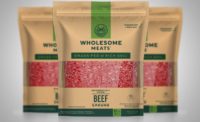For the love of fresh fish: How retailers can reel in sales
Prepackaged, grab-and-go items drive sales.

Photo courtesy SEE
Following a couple of record-setting years, seafood sales slowed in 2022, but consumers are still showing a strong interest in the health benefits of seafood. This is particularly true for fresh fish consumers, who are expanding it to a weekly staple in their family meal planning.
And while demand is high, it also can pose a conundrum for retailers and fish processors. How do you appeal to consumer desires for the freshness, taste and quality of fresh fish, while also considering ongoing interest in convenience, ease of use and the desire to reduce spoilage and food waste?
Adding into the mix of the myriad things to consider are the vanishing number of full-service counters as well as growing consumer interest in choosing products with sustainable packaging features that help reduce waste.
To better understand the seafood consumer and how both retailers and fish processors can take advantage of marketplace opportunities, SEE initiated an in-depth research study in 2022 of U.S. fresh and frozen fish consumers. SEE’s “2022 Seafood Study” builds onto the insights from our 2018 study and reveals current trends in the market, including the opportunities to optimize packaging, sustainability and convenience.
The fresh fish consumer
While the study found more crossover usage between consumers buying both fresh and frozen over the past few years, consumers still appreciate the qualities of fresh fish more than frozen fish. Attributes such as freshness, harvesting location, and sourcing operations being particularly appealing.
Since 2018, the interest in fresh fish (never frozen) has risen from 51% to 58% and the attributes fresh fish shoppers also look for are wild caught (45%), farm raised (30%), prepackaged (30%) and sustainable sourcing (27%).
In addition, customers value the taste and quality of fresh fish (71%) over anything else. Other top attributes include having better nutrition and texture along with cooking convenience.
On the other hand, frozen fish purchasers tend to value shelf life, ease of storing, and lower costs when analyzing a meal purchase with less regard for nutritional value, taste, or quality.
Fresh fish, it’s what’s for dinner
Since the 2018 study, more consumers are purchasing fresh fish for the entire family or households, from 53% in 2018 to 68% in the most recent findings.
Despite this interest, there are hurdles to overcome… specifically as it relates to meal planning and shelf-life. Fresh fish is much more likely than frozen fish to be consumed the same day it was purchased with 42% saying they purchase and consume in the same day and another 42% saying they consume within three days of purchase.
As consumers are down to one or two grocery trips per week, the ability to purchase fresh fish for the days or week ahead versus same/next-day consumption could help inspire a purchase.
Strong Interest in extended shelf-life packaging for fresh fish
As consumers continue to look for ways to make meal planning easier, they expressed a strong interest in the idea of fresh fish packaging that would keep fish at optimal freshness for 10 days or more without being frozen.
This would allow for more flexibility in meal planning and the added convenience that consumers desire.
- 69% of consumers expressed a strong interest in this type of packaging benefit that would extend the shelf life of fresh fish.
- And while an added cost deterred some, still 56% were interested even with a 5% cost increase.
Ideally, fish sold in this package would be prepackaged before the fish is sent to the store, taking any labor concerns away from the retailer as well.
With high interest in self-service, prepackaged options, there appears to be an opportunity to appeal to customers who value the extended shelf life of frozen fish and the higher qualities of fresh fish.
The influence of sustainable packaging
Package sustainability is on the minds of both fresh and frozen fish consumers with reduced plastic and packaging waste among the highest-rated sustainability features that consumers look for.
When it comes to case-ready seafood – a category that continues to trend in 2023 – shoppers have specific packaging material preferences in mind.
Consumers are looking for more sustainable packaging formats, and paper and fiber are top of the list. The 2022 study found that across five different options, plastic-sealed fiber (53%) and paperboard with plastic vacuum film (60%) were viewed as the most sustainable. All vacuum options also saw a high purchase intent among those surveyed.
Opportunity and trends in the seafood self-service case
With full-service counter usage down from 2018, there already is a shift to a greater emphasis on prepackaged items.
In the seafood self-service case, 61% of packages are case-ready. This marks a significant increase from the 46% of case-ready packages in 2018.
We’re seeing a shift away from foam trays due to sustainability concerns, but they still are a big part of packaging seafood, especially when packaging is done in store. However, we’re also hearing concerns from consumers with respect to freshness with foam trays because they typically don’t have that kind of high-quality packaging that vacuum-skin or prepackaged items can offer.
All this means there is a great opportunity to meet consumer demand and encourage more sales with more pre packaged, grab-and-go items that consumers prefer because it reduces their wait time, is hassle-free and can keep fish fresher longer.
When fresh seafood is case-ready and prepackaged, it also makes online order fulfillment at grocery stores run more smoothly and keeps the category competitive in the digital realm.
Adopting more vacuum packaging techniques in this section of the store is a prime area of opportunity for the seafood industry and ideally should go hand-in-hand with consumer education on extended quality life by maintaining better moisture levels in the fish.
By implementing these strategies, retailers and fish processors can take advantage of growing consumer interest in fresh fish and increase sales and customer loyalty.
Looking for a reprint of this article?
From high-res PDFs to custom plaques, order your copy today!






